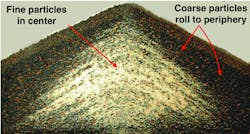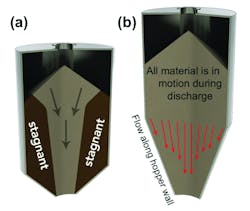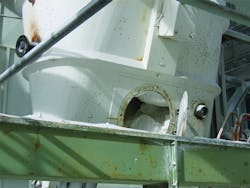Preventing flow problems with reliable bulk solids handling equipment design
More than 70% of all products contain ingredients that are handled in bulk solid form at some point during their production process. Even with all this handling, many of the most basic fundamentals of bulk solids handling remain poorly understood — largely because our STEM education typically only focuses on handling liquids and gases, and not bulk solids. This often leads to little consideration of material handling equipment design requirements. As a result, numerous flow problems occur that significantly delay project startups, bottleneck production, impact product quality, increase labor requirements and even create unsafe working conditions.1,2
This article touches on some of the most common problems encountered when handling bulk solid materials and offers a proven and practical scientific approach for designing bins and feeders based on a material’s flow properties. This approach has been used successfully for more than 60 years to mitigate many common flow problems.3,4
Flow problems
While flow issues that can impact production rate and product quality occur in all types of bulk solids handling equipment, there are a set of flow problems that most commonly occur in storage bins and silos.5
Some of the most common are:
- Arching or bridging: A no-flow condition in which material forms a stable arch-shaped obstruction over a hopper outlet (Figure 1a).
- Ratholing: A no-flow condition in which material forms a stable open channel above the outlet during discharge and stagnant material outside of the flow channel does not empty (Figure 1b). Ratholing can result in erratic flow and a complete flow stoppage when the flow channel is emptied and can reduce the bin’s "live" capacity by as much as 90%.
- Limited discharge rate: A condition in which there is not enough flow, when counter-flowing air at the hopper outlet slows the discharge rate of fine powders.
- Flooding or flushing: A condition in which there is too much flow, when the bulk solid behaves like a liquid and flows uncontrollably through the bin outlet if the downstream feeder is not properly designed to handle fluid-like material.
- Segregation: A condition in which a material’s particles separate, primarily by particle size differences, that may result in variations in product size, density and chemistry. Segregation can result in product nonuniformity, out-of-spec product, package weight fluctuations or decreased flowability, and may require costly reprocessing. One of the most common segregation mechanisms, sifting, is shown in Figure 2. Sifting causes the fine particles to concentrate in the middle under the fill point, and the coarser particles to roll off to the sides.
- Particle degradation: A condition in which stagnant material may spoil, oxidize or cake into a solid mass, potentially affecting product quality and/or causing flow stoppages.
Many of these problems typically occur as a result of improper equipment design — if the equipment is not designed appropriately, even the easiest-handling bulk solid may experience significant problems. However, so long as the engineer is cognizant of both the material’s flow behaviors and understands the rules for proper equipment design, reliable flow may be achieved.
Figure 2. Side-to-side sifting segregation.
Flow patterns
Perhaps the most fundamental behavior of a bulk solid is its flow pattern in a converging hopper — whether it discharges in funnel flow or mass flow.
Funnel flow (Figure 3a) has a first-in-last-out flow sequence in which only some of the material is in motion during discharge. This may occur when the hopper walls are not steep enough or low enough in friction for material to flow along them, and/or when the feeder or gate below only activate a portion of the cross section of the outlet. Funnel flow results in dead material at the periphery and only a small active channel above the hopper outlet. As the material level in the hopper decreases, stagnant material from the periphery may or may not slide into the flowing channel, depending on if the material is cohesive enough to form a rathole. Funnel flow can also cause nearly all of the aforementioned flow problems and result in poor inventory control, cross-contamination, and nonuniform discharge with variable bulk density. It also may lead to uncontrolled flooding of fine powders and will exacerbate the impact of sifting segregation on product uniformity as finer particles in the center come out first and coarser particles at the sides come out last.
Mass flow (Figure 3b), on the other hand, has a first-in-first-out flow sequence in which all of the material is in motion during discharge. This occurs when the hopper walls are sufficiently steep and low enough in friction to allow material to flow along them, and the feeder is properly designed for flow across the entire outlet. Since mass flow hoppers eliminate stagnant material, ratholing is prevented and material degradation is reduced. Mass flow hoppers also provide a steady, well-controlled discharge with a consistent bulk density, limit the risk of uncontrolled flooding of fine powders and minimize side-to-side sifting segregation effects as coarse and fines discharge at the same time and are effectively remixed at the outlet.
Figure 3. The two primary flow patterns, funnel flow (a), and mass flow (b).
Achieving mass flow in the hopper
Mass flow should be used when your application meets one or more of the following criteria:
- Your material is cohesive enough to form a rathole.
- Your material is a fine powder that may become aerated and behave like a liquid.
- Your material is prone to sifting segregation, and variations in product uniformity are a concern.
- Your material may degrade over time by caking or spoilage.
- If cross-contamination may be an issue.
- If it is important to discharge with a consistent bulk density to avoid feed rate fluctuations.
Otherwise, a more economical funnel flow bin design with a more shallow, lower-headroom hopper may be acceptable.
To achieve mass flow and ensure all of the material is in motion during discharge, the hopper outlet must be sized large enough to prevent arching and achieve the required discharge rate, the hopper walls must be steep enough and low enough in friction for the material to flow along them, and the feeder below the hopper must be properly designed to discharge material over the entire outlet cross section.
To determine these critical parameters for reliable hopper design, it is important to perform testing on your material to measure its flow behaviors using proven test methods.6,7 These key flow properties tests — which include cohesive strength, internal and wall friction, bulk density and gas permeability of fine powders — may be used to predict and control how your material will flow in a given bin or hopper geometry.
It is essential to perform these tests under representative conditions that simulate the actual handling conditions (e.g., moisture content, time at rest, temperature and relative humidity), otherwise the tests may not properly account for the worst case design parameters.8 As an example, some materials like many salts, sugars and urea may be free-flowing when they are kept in motion. However, if they are allowed to remain at rest or handled in funnel flow, they may adsorb moisture from the air and cake into large clumps or solid masses that may not come out of the hopper regardless of outlet size, even at ambient temperature and humidity conditions (see Figure 4 for an example). In these cases, it may not be enough to simply design the hopper for mass flow — rather, the process conditions may also need to be changed to reduce flow problems.
Figure 4. Example of moisture-driven caking of powder in mass flow hopper resulting in flow stoppage.
Maintaining mass flow with the feeder below
Unfortunately, designing the hopper for mass flow is only part of the equation for eliminating many of the most common flow problems. If the hopper outlet is only partially active due, for example, to an improperly designed feeder or a partially closed gate below, even the best mass flow hopper design will discharge in funnel flow. As a general rule, gates should only be operated fully-open or fully-closed, and feeders should be designed to:9
- Provide reliable flow from the bin above.
- Control the discharge rate.
- Remove material over the entire cross section of the outlet to maintain mass flow in the hopper.
For example, if a constant pitch screw feeder is used below an elongated-slotted outlet, material will only flow into the first pitch at the back of the screw and will be dead over the rest of the hopper, resulting in funnel flow, even if the hopper above is designed for mass flow (Figure 5). A properly-designed mass flow screw, on the other hand, is designed with increasing capacity in the direction of flow to allow uniform withdrawal over the entire hopper. Belt feeder and apron feeder interfaces below elongated outlets must also be designed with increasing capacity in the direction of flow to avoid the same problems.
Figure 5. Feed with a constant pitch screw vs. a properly designed mass flow screw.
Conclusion
Bulk solids handling often creates critical bottlenecks that can limit production quantity and quality due to flow problems. These commonly occur as a result of improper equipment design. Fortunately, flow issues can be predicted and prevented by performing flow properties testing on your material. By using data and the proven scientific design approach, you can reliably and effectively ensure your bulk solids handling operations deliver the desired performance.
References
- Carson, J. W., Maynard, E. P., Wellwood, G., "Safely Storing and Handling Bulk Solids." Processing Magazine, July 2019, pp. 16-18.
- Wellwood, G., "Bulk Materials Science; The Missing Competency in Many Projects." Australian Bulk Handling Review, September/October 2016, pp. 30-32.
- Hartford, C., "Bulk Solids Handling System Design – Measuring Flow Properties Leads to Proper Equipment Selection and Process Reliability." Processing Magazine, Volume 29, No. 11, November 2017, pp. 56-59.
- Maynard, E., "Ten Steps to an Effective Bin Design." CEP Magazine, November 2013, pp. 25-32.
- Maynard, E., "Retrofitting bins, hoppers, and feeders to solve flow problems." Powder & Bulk Solids Magazine, Volume 30, No. 12, December 2016.
- Jenike, A. W., "Storage and Flow of Solids." Bulletin 123, University of Utah Engineering Station, 1964 (revised, 1976).
- ASTM D6128-16, "Standard Test Method for Shear Testing of Bulk Solids Using the Jenike Shear Tester." ASTM International, 2016.
- Hartford, C., Pittenger, P., "Steps to Overcome Flow Problems." SPE ANTEC Anaheim 2017, pp. 2070-2073.
- Carson, J. W., "Step-by-Step Process in Selecting a Feeder." Chemical Processing, 2000, Powder & Solids Annual, pp. 36-37.
Josh Marion is a project engineer at Jenike & Johanson’s office in Tyngsboro, Massachusetts. He has been with Jenike & Johanson for more than six years and has worked on hundreds of projects where he has designed new systems and retrofit modifications to existing systems to ensure reliable flow and transport of bulk solids. Josh received his bachelor’s and master’s degrees from Northeastern University. He may be reached at [email protected] or 1-978-649-3300.






